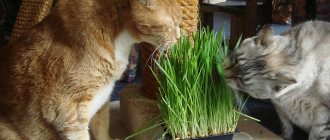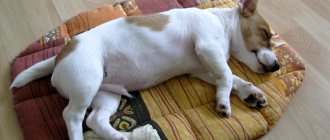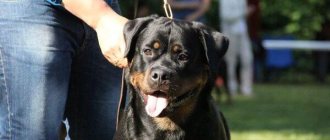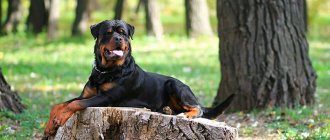Training is important not only for establishing contact with the owner, but also for maintaining basic order. A puppy that doesn't know its place will become a source of anxiety and will ultimately not recognize its owner's leadership. From the first days a pet appears in the house, it is important to know how to teach a dog the “Place!” command. This skill can be acquired by both an early-age animal and an adult pet. Naturally, before starting training, you should prepare a convenient and comfortable corner for relaxation. This material consistently reveals the topic of animal adaptation to new conditions.
How to teach your dog the command “Place!”
What is the "place" command used for?
As a rule, the “place” exercise is used in two cases: as a standard when passing a general training course and as a command for living comfortably with a pet at home.
For example, you have guests coming over or you are planning to cook, and you don’t want your pet getting under your feet to interfere with the process. In this case, the “place” command will be very useful to you.
In addition, any dog should have a corner, its own personal space, where it can calmly relax and unwind mentally.
It is very important that you or other family members do not touch the animal in its place. By doing this, you let the dog know that no one will touch him or give him undue attention when he wants to rest.
If the dog does not have such a place, he may begin to get stressed, because he simply will have nowhere to relax.
Signs of anxiety
Quite often, even an adult dog, not to mention a puppy, noticing that the beloved owner is getting dressed, collecting things and going to the door, forgetting to grab the pet, falls into a panic. She begins to whine, bark, get underfoot, lie down on the threshold, blocking the way, and even grab her legs with her teeth. This is unpleasant and even dangerous - a young dog may well miscalculate his strength and injure his owner. And not every person can withstand the almost crying look of a dog.
However, this is quite natural - something worth understanding if you want to know how to train your dog to stay home alone. There is no need to worry, even if at these moments she shows certain signs of illness, such as a suddenly dry and warm nose. This is stress that can be easily eliminated with simple training. But first you need to understand why the dog shows its feelings so clearly.
Features of the OKD standard
As you already know earlier, the “place” command is also used for the purpose of passing a general training course. The everyday exercise and the “place” command in the OKD standard are different. How is the task performed in the OKD form?
The handler asks the dog to lie down, after which he places a thing in front of him (a bag, backpack or other object familiar to the animal), then gives the command “place”. After thirty seconds, the trainer calls the dog to him using the command “come to me.” The animal must remain in a sitting position for fifteen seconds, after which the “place” command is again given to it. The position of the dog near the object is taken into account: the distance of the animal from the object should not exceed one meter.
As soon as the dog has completed the “place” command, the trainer approaches him and asks the pet to sit down - at this stage the exercise ends.
What should you do first?
Give the puppy a place in a cozy corner, if possible not in the aisle, away from heating appliances, not in the kitchen or on the balcony. It is quite understandable that sometimes it is not possible to fulfill all these requirements, nevertheless, try to create some semblance of comfort for the puppy.
As a place for the dog, you can simply use a bedding or rug, a mattress, a dog bed, a special bed for dogs, or a lightweight foam booth covered with durable fabric. You should not immediately purchase expensive mattresses or bedding, since the puppy may not always like them. Manufacturers of pet products offer a wide range of different options for dog resting places, from which you will surely be able to choose something that suits you. It is clear that you need to focus on the future size of the dog, but first, a place to rest, even if in the future the puppy grows into a large dog, you need to choose based on the current size of the puppy with a reserve of 3-4 months - later you will need a bedding, rug or bed change to a larger one.
Choice of treats
Reward plays a significant role in training - it gives the animal motivation. It is very important to choose the right treat for your pet.
Each dog is individual and has its own characteristics, including taste preferences.
That is why, unfortunately, there is no single treat for all animals. Some people like chicken, while others prefer liver. Some four-legged animals will happily work for pieces of vegetables!
If you think that your dog is very picky and is not interested in any food, then you have not done a good job in choosing treats. Maybe your dog will be ready to sell his soul for cottage cheese?
Try offering your pet more options for treats. Observe which ones your dog likes the most. Supermarkets have a huge selection of meat by-products: hearts, lungs, liver, kidneys, stomachs, udders.
For classes, it is better to cook meat products, solely for your convenience. But if it’s not important to you, and the dog prefers raw meat, then please reward your pet with raw products.
Attention! Your pet may be allergic to certain types of foods. Be sure to monitor his body’s reaction and consult a specialist.
Causes of excitement
Everything here is surprisingly simple. A dog, especially a young one, is extremely emotional. Look at people - an adult, knowing that close people are leaving him, also worries and feels discomfort. But he easily subordinates his feelings, does not demonstrate them, understanding that no one wants to be separated, but this is a necessity. The child shows feelings much more vividly - asks not to leave, cries, begins to play around.
The situation is exactly the same with a dog. When she gets a little older, it will go away.
It's a different matter if the dog is afraid to be left alone at home. What to do in such a situation? Unfortunately, such problems are almost always the fault of the owner himself.
On the one hand, it is generally not advisable to have a dog if it spends 8-12 hours a day alone. Imagine yourself in her place. The fate of spending half your life alone, not being able to do the things you love, is far from sugar.
Therefore, you need to give your pet the opportunity to spend the time you spend together as interesting and eventful as possible.
Selecting a location
The bed, first of all, should be located in a place that is comfortable for the dog. Ideally, this is a quiet and remote corner.
The place should not be located in a corridor or room where there are almost always a lot of people. Eliminate noise sources near the bed, as well as all possible factors that could cause stress in the animal. There should be no draft in the place.
Arrangement of the place
Choose a soft bed on which the dog can easily lie down. If the place is on a cold concrete floor, prefer a lounger with a thick tray.
Provide leisure time for your pet
Another reason why a dog does not want to be left alone at home is simple boredom. She cannot read books, surf the Internet, watch TV or go for a walk. As a result, it is out of boredom that she begins to have fun as best she can.
As a result, rolls of toilet paper, plastic bags, papers and books that are not put away far enough are torn to shreds. Shoes and any clothing, mobile phones, chargers, remote controls and any other items that are in a place where a young puppy can reach are used. And believe me, he can get almost anywhere.
On the one hand, the pet needs to be punished. But not too harshly - after all, you yourself are partly to blame for this mess. In addition, dogs have short memories, especially puppies. If several hours have passed between the crime and punishment, he may not make the connection. At the same time, in no case should you take all the blame on yourself - having realized that the violation is not followed by punishment, the dog will become completely uncontrollable. Show the offender the damaged object, shout at him and slap him on the butt with a suitable object (not your palm or a leash, so as not to cause fear of petting and walking). It shouldn't hurt him - just an unpleasant sensation. The slap should be accompanied by a shout - sharp, loud and short. The dog must understand that the owner is dissatisfied with his behavior. And any unspoiled puppy or dog really does not like to upset the owner.
To prevent this from happening (or at least not on such a scale), remove all valuable and fragile items away, leave enough food, water and toys so that your pet has something to do while you are not home.
Ways to train a puppy and an adult dog
There is no difference between training a puppy and an adult dog. The methods apply the same to everyone. The only thing is that there are differences between the duration of the approaches:
- A puppy under 4 months should be trained in short approaches, starting with a minute and ending with three minutes. Gradually increase the time of approaches, do not start training immediately with a five-minute lesson. Do several of these throughout the day.
- An older puppy should also be trained, starting with short approaches. Here you can increase the time slightly, gradually arriving at a 10-minute session. Don't forget to take breaks between sets. You can exercise your puppy in the morning, lunch and evening. The main thing is not to stretch out your classes for too long.
- With an adult dog, start training as you would with a puppy, with two-minute approaches. A pet cannot be fed with long, same type of training. Especially if the animal is not yet accustomed to training. Gradually, you can move up to a fifteen-minute lesson. Don't forget to take breaks. You can play with your dog during the training process - this will prevent the animal from overloading its brain.
Method 1
Sit next to the lounger. It is better to be at approximately the same height as the animal to make it more comfortable. Use treats to draw your pet's attention to you. Extend your hand with food to the dog’s nose and smoothly point it towards the bed.
If the animal does not follow the hand with a treat well, first give the treat a few steps away, gradually requiring the dog to come closer to the bed. As soon as your pet puts at least one paw on the bed, immediately reward him.
Next, ask the dog to put up several paws, and then all four. As soon as your pet confidently climbs onto the bed, remove your hand away from his nose, giving the animal the opportunity to enter the place on his own.
Remove your hand not abruptly, but gradually, turning it into a gesture.
After the dog understands what you require from it, you can smoothly move away from the bed. First, take a step back, increasing the distance to several meters.
If at some point the pet gets lost and is unable to enter the place on its own, return to the stage below, reducing the distance and expressing the command with a clearer gesture.
As soon as you see that the dog is confidently completing the task, enter the voice command “place”. Keep in mind that your pet should not leave the place without your permission.
The end result will be that the pet will go to the place at your command from another room.
Method 2
This method is called "shaping". It takes longer, but with its help the dog learns to think and offer different options for executing the command.
Grab a treat and sit next to the spot. Let your dog sniff your hand with the treat, but do not give it to your pet. The dog will try to take the treat, run around you, or even bark.
You don't have to react to incorrect behavior, just wait. As soon as your pet even looks in the direction of the lounger, give him a treat.
Repeat this several times, then increase the criteria. This means that now the look of the dog on the lounger is not enough for you.
You now need the pet to take a step towards the place. As soon as he does this, praise your pet thoroughly.
Gradually, require the dog to take more steps towards the bed until the dog begins to step on it. First praise the dog if he steps on one spot with one paw, then for two, three and four.
Repeat this several times, after which you can enter the gesture. If the dog confidently enters the bed, gradually begin to move away from it - first one step, increasing the distance to several meters. Enter the voice command "place".
After your pet has clearly mastered the skill, you can begin to ensure that on your command the dog goes to the place from another room.
Weaning off sofas, beds and armchairs
The hardest thing is to train animals that are accustomed to sleeping on the owner’s furniture. Here it is important to adhere to cohesion among household members and mandatory punishment for disobedience.
If you notice an attack on your bed, say loudly “No” and take the dog to its bed. If she rushes back, repeat the ban and lightly press her to the floor, demonstrating your leadership. Repeat these steps until you see results.
IMPORTANT!
If you are against sleeping together, then never violate the established ban. Otherwise, you will undermine your authority in the eyes of the dog.
Possible mistakes
- Working with a leash. Do not try to attach a leash and drag the dog into place by it. Even if you are already working with treats. Jerking will not help the pet learn the exercise, but will only spoil the dog’s attitude towards training and towards you.
- Too many treats for one reinforcer. In order for your dog to be willing to contact you, do not give him a mountain of treats at once. Encourage your pet often, but little, otherwise he will quickly get full and will not be interested in the training process.
- Abrupt transitions from one stage to the next. Always move to new steps in learning smoothly and gradually. If you dramatically complicate the dog’s task, for example, almost immediately trying to send the animal to its place from another room, the pet simply will not understand what they want from it.
- Constant help for your pet. If the dog, after he has succeeded in executing the command “place” several times, begins to offer other options that are unnecessary to you, do not immediately point him to the bed with a treat. Give your pet the opportunity to think, don’t do everything for him. Keep in mind that if the dog fulfilled your request incorrectly more than three times, your help in guiding him to the spot with a treat is already important.
Summarizing
Teaching a dog the “Place” command is not as simple as it might seem at first glance. The animal must be aware of why it needs to carry out this command and for what reason. For example, if a dog behaves badly, shows aggression towards other animals, and does not do what the owner says, then this command will be appropriate. But not everyone uses this command as punishment. Many owners say to the dog: “Place” when they need to leave the pet, for example, near the store.
In any case, under whatever circumstances you use the “Place” command, you should remember that you need to pronounce it without aggression, in a calm voice, so as not to offend or frighten the dog, and especially a small puppy. If you understand that you cannot cope with training your pet on your own, then you can turn to dog trainers.
Experienced specialists with many years of experience in this field will quickly be able to teach your pet all the necessary commands in the shortest possible period of time. Therefore, trusting professionals is an excellent solution for every caring owner.
Briefly about the main thing
- Choose a quiet, secluded place in the house where you will place the lounger. The place should be soft and pleasant for the dog.
- Train your pet, starting with small approaches of a few minutes. Gradually, you can move on to longer sets. Don't overdo it with training.
- Use treats to guide your pet towards the bed. First, reward your dog for the smallest actions in the right direction. Next, you can gradually increase the criteria and demand more from your pet.
- Train your dog gradually, without moving to a new stage too abruptly, and also reward the dog with treats often, but little. Also, allow the dog to think during the training process, do not do everything for him, returning to the previous stage immediately after the first unsuccessful attempt. Forget about using a leash.
We hope that thanks to our tips, your four-legged animals will easily learn the “place” command. You can share your opinion about the article or ask a question, we will be happy to answer you! We wish you and your tailed good luck!
Did you like the article? Share it with your friends on social media. networks. This will help them get useful information and support our project.











